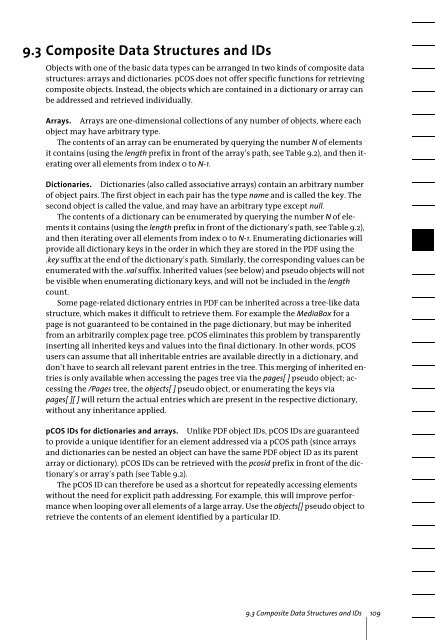PDFlib Text Extraction Toolkit (TET) Manual
PDFlib Text Extraction Toolkit (TET) Manual
PDFlib Text Extraction Toolkit (TET) Manual
Create successful ePaper yourself
Turn your PDF publications into a flip-book with our unique Google optimized e-Paper software.
9.3 Composite Data Structures and IDs<br />
Objects with one of the basic data types can be arranged in two kinds of composite data<br />
structures: arrays and dictionaries. pCOS does not offer specific functions for retrieving<br />
composite objects. Instead, the objects which are contained in a dictionary or array can<br />
be addressed and retrieved individually.<br />
Arrays. Arrays are one-dimensional collections of any number of objects, where each<br />
object may have arbitrary type.<br />
The contents of an array can be enumerated by querying the number N of elements<br />
it contains (using the length prefix in front of the array’s path, see Table 9.2), and then iterating<br />
over all elements from index 0 to N-1.<br />
Dictionaries. Dictionaries (also called associative arrays) contain an arbitrary number<br />
of object pairs. The first object in each pair has the type name and is called the key. The<br />
second object is called the value, and may have an arbitrary type except null.<br />
The contents of a dictionary can be enumerated by querying the number N of elements<br />
it contains (using the length prefix in front of the dictionary’s path, see Table 9.2),<br />
and then iterating over all elements from index 0 to N-1. Enumerating dictionaries will<br />
provide all dictionary keys in the order in which they are stored in the PDF using the<br />
.key suffix at the end of the dictionary’s path. Similarly, the corresponding values can be<br />
enumerated with the .val suffix. Inherited values (see below) and pseudo objects will not<br />
be visible when enumerating dictionary keys, and will not be included in the length<br />
count.<br />
Some page-related dictionary entries in PDF can be inherited across a tree-like data<br />
structure, which makes it difficult to retrieve them. For example the MediaBox for a<br />
page is not guaranteed to be contained in the page dictionary, but may be inherited<br />
from an arbitrarily complex page tree. pCOS eliminates this problem by transparently<br />
inserting all inherited keys and values into the final dictionary. In other words, pCOS<br />
users can assume that all inheritable entries are available directly in a dictionary, and<br />
don’t have to search all relevant parent entries in the tree. This merging of inherited entries<br />
is only available when accessing the pages tree via the pages[ ] pseudo object; accessing<br />
the /Pages tree, the objects[ ] pseudo object, or enumerating the keys via<br />
pages[ ][ ] will return the actual entries which are present in the respective dictionary,<br />
without any inheritance applied.<br />
pCOS IDs for dictionaries and arrays. Unlike PDF object IDs, pCOS IDs are guaranteed<br />
to provide a unique identifier for an element addressed via a pCOS path (since arrays<br />
and dictionaries can be nested an object can have the same PDF object ID as its parent<br />
array or dictionary). pCOS IDs can be retrieved with the pcosid prefix in front of the dictionary’s<br />
or array’s path (see Table 9.2).<br />
The pCOS ID can therefore be used as a shortcut for repeatedly accessing elements<br />
without the need for explicit path addressing. For example, this will improve performance<br />
when looping over all elements of a large array. Use the objects[] pseudo object to<br />
retrieve the contents of an element identified by a particular ID.<br />
9.3 Composite Data Structures and IDs 109
















